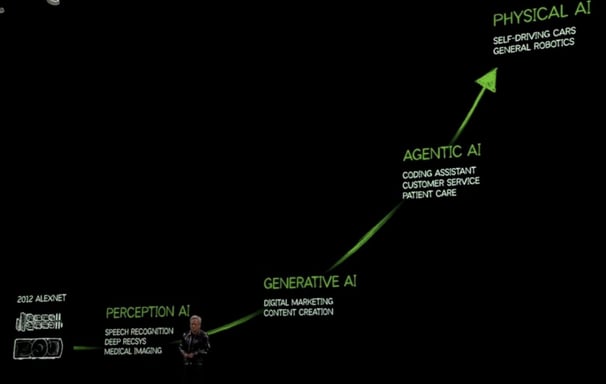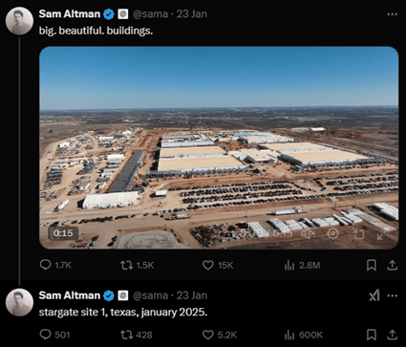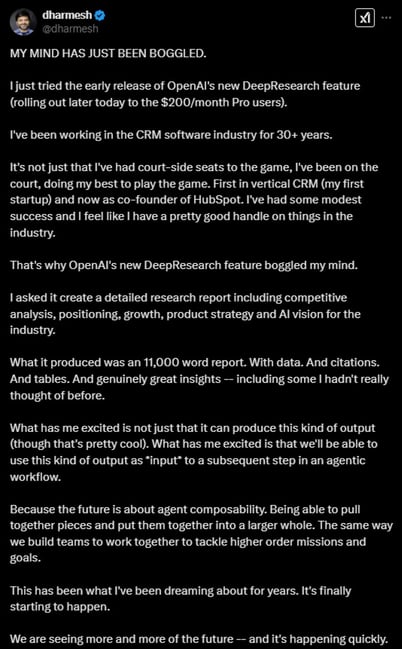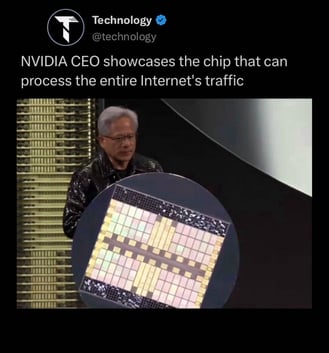AI in business (and how to position)
My view on the bigger picture of AI in business, how you need to understand how to use AI or AI tools and how I aim to position
John Paul Hipkin
2/22/20258 min read


Even as I write this, AI technology is advancing at such a pace that some of the information contained here will likely be outdated within a week… New advancements, announcements and models are being released daily.
This is therefore a snapshot assessment in time and how I see it going.
Likened to the “Manhattan project”: the race to the Nuclear Bomb, – the AI “Arms Race” has already started. China and America, the current front-runners, although others will follow.
Where we’re at
In President Trump’s second Inauguration, America set out the stall …. “Project Stargate will invest $500bn into AI and AI infrastructure” so that the US will be the market leader. The Tech Giants’ CEO’s all shouldering the president. Sam Altman (OpenAI- ChatGPT CEO) revealed the project is already building mega datacentres in Texas, Mark Zuckerberg said he will invest $55-65bn in AI infrastructure for META, X have dedicated $6bn, the list goes on.
Stargate 1 - Mega datacentres (Source: https://x.com/sama/status/1882505650594611588)
AI is a term that is oftentimes bandied about too easily (calling any software solution “AI”). To be specific, Large Language Models (LLMs) such as ChatGPT (OpenAI/Microsoft), Deepseek (Chinese startup), Gemini (Google), Llama (Meta) are the spearhead of this technology.
The company NVIDIA currently holds the key to AI development with their Graphics Processing Chips (GPUs) and is currently playing a significant role in the AI race war. Their chips are unique and as yet, nobody has been able to replicate them, but they enable LLMs enough compute to train them and operate. President Trump immediately passed a bill to limit the number of NVIDIA chips exported to China or any country who would loan them to China, to slow China down. These chips are predominantly manufactured in Taiwan’s 👀 Semi-Conductor Manufacturing Company (TSMC) plant - alongside semi conductor chips which are integral for almost every bit of modern technology from your smartphone, car to your dishwasher. It’s strongly posited that the next “hot war” could be over the developed world’s reliance on this single company, seeing China invading Taiwan to seize it and the US and allies scrambling to intercept. I wonder if any geopolitical tensions will rise there again in the near future?
On 20th January 2025, China shocked the AI world with the release of Deepseek R1 model, which on many fronts was equal or better than all of the competitions’ current LLMs. They claimed to have trained their newest LLM model with only 100 NVIDIA chips for a fraction of the price of $5-6M. ChatGPT in comparison took $billions to train and thousands of NVIDIA chips. Even if all these claims aren’t exact, what was clear was that they had made massive innovations and efficiencies in comparison to all their competitors. However, the Chinese companies biggest play, was to release all of their technical papers and open source their code to show the rest of the world how to do it. “F@*k You ‘Murica!”
The advancements are becoming faster and faster. Competitive Coding is a scoring measure to show how efficiently and quickly individuals can code and solve programming problems. ChatGPT’s o1 reasoning model (released Jan 2025) has ranked 175th in the world, with claims that their new internal model is as high as 50th worldwide[1]. It is likely these will exceed the #1 spot within the year.
Energy requirements
The energy and data required to allow these systems to work is exponential to what we’ve seen before. It’s not new that technology revolutions require significantly more energy (how many fossil fuels were burnt to start the industrial revolution?) or that industry needs energy and is always closely linked to where it is.
China is currently winning this race as a possible outcome of having autocratic characteristics. They are somewhat of a paradox, building coal factories at a rate of one every few days - accounting for 95% of the world's new coal power construction activity in 2023[2]. On the other hand, they are now one of the world leaders in renewable energies and their energy security is typically far superior to other superpowers. China has the resources for energy generation and can make these associated decisions far quicker than their western counterparts. They are far better geared up for this situation in the coming years.
Why is it different to other technologies?
Yuval Noah Harari in his brilliantly accessible books, the most recent of which is called “Nexus– A Brief History of Information Networks from the Stone Age to AI”, eloquently explains that language is how humans dominated the world. Stories (and fictions) is the primary nexus through which one could convince large numbers of humans to (somewhat) cooperate. Money, law, religion, nations, politics, human rights can be classed as “intersubjective realities” as we’ve made them up – the dinosaurs didn’t need them. What sets AI apart is that AI is the first “nexus” that humans won’t fully control. Clay tablets, Scriptures, Newspapers, Radio, the internet, social media all expanded the ability to tell these stories to larger and larger audiences, but the one key point was that the input and control has always been human. A newspaper article couldn’t write itself, a radio station address to the nation couldn’t make its own broadcast. A.I. will have this ability.
So why the “AI Arms Race”? What’s the race for?
Artificial General Intelligence (AGI) is what this AI race is primarily towards (to begin with at least). AGI can have varying descriptions but in its simplest definition is “the theoretical point of artificial intelligence that has the capacity to understand, learn, and perform any intellectual task that a human being can, across a broad range of domains, without requiring task-specific programming.” As you can imagine there is a wide range of predictions, however, many of the industry experts are predicting that this could easily occur between 2026 to 2030. Not far.
The internet is about to become even weirder
Max Tegmark’s book “Life 3.0”, and Netflix’ “Black Mirror” episodes, depict varying utopian and dystopian futures and scenarios involving the AI revolution. As a general consensus, it’s considered having multiple powerful AI is at the very least, less dangerous than having one powerful AI. Open Source (opening your workings out to everyone) is also generally considered safer than closed source. However, the AI race does create one major safety concern – either the brakes are off or at best, are being dismantled.
Jensen’s Huang, NVIDIA’s CEO, showed the following predictions for the next stages in AI at CES 2025 earlier this year: Perception AI, Generative AI, Agentic AI, Physical AI.
Source: https://x.com/IntuitMachine/status/1876952442568392915
Meta and many of the other major tech giants have made recent announcements that they will be releasing “agents this year”. 2025 will be a weird year on the internet, growing stranger and stranger as the years progress, where determining what is real or even human will become even more difficult, as the lines are blurred.
The thing I take from this, is that those with physical skills in the workforce, will (contrary to the original fears for blue collar jobs) actually retain their value the longest, as physical AI will take the longest to master on the engineering side, and therefore longer to affect real jobs.
NVIDIA also showcased the NVIDIA GB200 NVL72 chip – which has the ability to process the entire world’s internet traffic in one chip the size of what looks like a futuristic medieval shield.
https://www.instagram.com/technology/reel/DE5Z7Gmp1sk/
It’s already happening
Leaders across varying industries are commenting on how it’s going to change everything. Economics won’t be the same, industries won’t be the same, society won’t be the same.
Dharmesh Shah, the co-founder of Hubspot (Leading Customer Relations Managaer (CRM) software), observed that after 30+ years in the CRM industry, OpenAI’s new DeepResearch feature was “mind boggling” and developed ideas/concepts he hadn’t thought about before. These models are creating research akin to PhD accuracy in seconds/minutes.
Source: https://x.com/dharmesh/status/1886510930420195816
Yes, there will always be overhype on many announcements, but things are happening now and happening quickly.
How I see it and how to position?
I’ve followed and read about this technology a fair bit over the last few years. I believe it could be likened to the same moment as when the internet first emerged, but 1000x more powerful and could go 1000x faster. It could be the same as when people dismissed building a website or thought emails or email marketing would never take off. You are either the early adopters/ early majority or not, but the ship is already sailing to gain competitive advantage.
If you’re not on board, you’re already being left behind.
Source: https://www.flickr.com/photos/jurgenappelo/6943418971
The language and jargon such as LLMs, Compute, GPUs and ExoFlops will be just as alien as when you first heard RAM, Megabytes and Floppy Discs for your first computer, but will become commonplace.
For me, AI in business will be a two-pronged approach:
Firstly, being skilled enough to know how to utilise AI and AI tools effectively so that you have a competitive advantage over others and garner superhuman productivity (you absolutely don’t have to code to do this). If you don’t even play around or explore its current capabilities, you’ll not know how to use it properly, or use it to solve the problems you have. Others will.
AI won’t take your job just yet or cost you your edge. But someone who knows how to use AI absolutely will.
I’m currently using it for business planning, meeting minutes, marketing, CGIs for developments, lead development and data analysis, alongside everyday activities, advice and learning…. At Black Dog Property we are going to build commercial spaces for small, medium and independent businesses and know I will only be scratching the surface at what it can be used for….
And secondly, understand how and where the energy security and availability is. As everything will need this energy, start to think strategically about where this is.
Lastly, be careful where you give your data. China’s Deepseek’s privacy T&C’s and use of your data are shockingly bad. Others might not be too much better but be conscious of what you’re signing up to. Also question the source and legitimacy of the information you are receiving, as this will become harder and harder to know what is true.
How are you using it? I’m always interested in hearing how people are applying it…. if any of this is of interest or want a chat – please reach out….
Note: I currently (Feb 2025) pay for the pro version of ChatGPT for roughly £19 a month - I find this has a lot more capabilities than the free version, but even this is far short of the pro models ($200+ a month) capabilities. There are hundreds of different LLMs and AI tools out there, all at varying price points.
Resources
Books
Nexus – A Brief History of Information Networks from the Stone Age to AI - Yuval Noah Harrari
Homo Deus – A Brief History of Tomorrow - Yuval Noah Harrari
Army of None – Autonomous Weapons and the Future of War - Paul Scharre
Life 3.0 - Being Human in the Age of Artificial Intelligence - Max Tegmark
Superintelligence: Paths, Dangers, Strategies – Nick Bostrom
The Science of Energy: Resources and Power Explained - Michael E. Wysession (Narrator, Author) & The Great Courses
Podcasts
Lex Friedman Podcast #459 – DeepSeek, China, OpenAI, NVIDIA, xAI, TSMC, Stargate, and AI Megaclusters https://www.youtube.com/watch?v=_1f-o0nqpEI
Blogs
Sam Altman blogs https://blog.samaltman.com/
Social media accounts
@Chatgpttricks https://www.instagram.com/chatgptricks/
@evolving.ai https://www.instagram.com/evolving.ai/
[1] https://x.com/WesRothMoney/status/1888335554003227075
[2] https://www.carbonbrief.org/china-responsible-for-95-of-new-coal-power-construction-in-2023-report-says/










